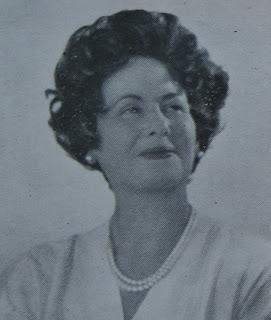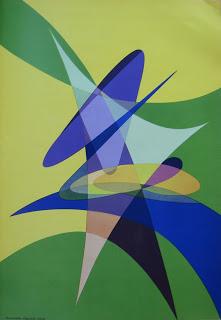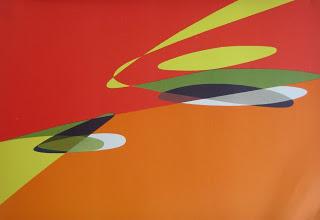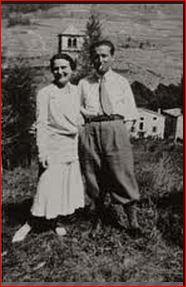 Simonetta Vigevani Jung (1917-2005)
Simonetta Vigevani Jung (1917-2005)The first of these is Simonetta Vigevani Jung. She was born Simonetta Irene Jung in Palermo, Sicily in 1917. She first exhibited in Milan in 1955, and in New York the following year at the Duveen-Graham Gallery. Her work is distinguished by its dynamic forms and vivid colours - though color is not an essential element of her art, as two cool black-and-white studies in line and form go to show. I have to say I personally prefer the color work, with its enticing sense of cosmic rhythm. Writing of her "Light Forms" (Forme Luce) paintings of 1955 (to which the first six of my lithographs are closely related), Albert Duveen remarks on their "lilting airiness": "The lyrical movements, detached and ethereal, are created with such vivacity that they bespeak of a joyous nature - their voluptuousness, a refined sensuality. Here then is a personal language, emotional but disciplined, stirring us to our very depth. Truly a revelation rarely produced before within the limits of the abstract."





 Simonetta Vigevani JungSix untitled lithographs (Forme Luce), 1955
Simonetta Vigevani JungSix untitled lithographs (Forme Luce), 1955
 Simonetta Vigevani JungTwo untitled lithographs, 1956-57
Simonetta Vigevani JungTwo untitled lithographs, 1956-57 Simonetta Vigevani JungUntitled lithograph, 1958
Simonetta Vigevani JungUntitled lithograph, 1958Though there is a monograph on her work by Giuseppe Marchiori, Simonetta Vigevani Jung seems to have fallen into underserved obscurity. She was first married to Angelo Vigevani with whom she had a daughter Diana. Vigevani died in a car accident when their daughter was seventeen years old. She remarried and then lived in Brussels with her husband Hubert De Schryver who was a Belgian consul. Simonetta Vigevani Jung died in Brussels in 2005.
 Carol Rama (1918- )
Carol Rama (1918- )The second female member of MAC is Carol Rama. One of Italy's most important female artists of the twentieth century, Carol Rama was born in Turin on 17 April 1918. Though she is now best-known for her provocative drawings and paintings exploring female sexuality, in a naive, almost "Outsider" style, in the 1950s Carol Rama was also an active member of the Movimento Arte Concreta. At this period she often spelled her name as one word, Carolrama. I really like her abstract compositions of this period, with their distinctive arrangements of block forms connected by thin rods.




 Carol RamaFive untitled lithographs, 1955
Carol RamaFive untitled lithographs, 1955 Carol Rama and Albino Galvano (1907-1990)Joint composition on one lithographic stone, 1956-57
Carol Rama and Albino Galvano (1907-1990)Joint composition on one lithographic stone, 1956-57Carol Rama's lifetime creating art was recognised at the 50th Venice Biennale in 2003, when she was presented with the Golden Lion for Lifetime Achievement. Major retrospectives have been held at the Stedelijk Museum, Amsterdam and ICA Boston (1998), at the Fondazione Sandretto Re Rebaudengo in her birthplace of Turin (2004), and at the Baltic Centre for Contemporary Art (2005). In 2003 the Esso Gallery, New York, staged the exhibition Carol Rama, past and present.
 Regina with her husband, Luigi Bracchi
Regina with her husband, Luigi BracchiLastly, I have two lithographs by the sculptor Regina Cassolo Bracchi, who worked simply as Regina. Regina was born in Mede in 1894, and studied at the Brera Academy. She studied sculpture under Giovanni Battista Alloati. A member of the Futurists from 1933, Regina was also a member of MAC. After the disbanding of MAC, Regina continued to work in a Futurist style.
 Regina (1894-1974)Untitled lithograph, 1955-56
Regina (1894-1974)Untitled lithograph, 1955-56 ReginaUntitled lithograph, 1956-57
ReginaUntitled lithograph, 1956-57Regina died in Milan in 1974. The Museo Regina in the Castle of Mede contains more than 500 works left by her husband the artist Luigi Bracchi. A 1991 monograph on her work by Luciano Caramel is now very hard to find. In 2010 the Fondazione Ambrosetti Arte Contemporanea staged an important exhibition on this neglected female artist, REGINA. Futurismo, arte concreta e oltre, curated by Paolo Campiglio.

